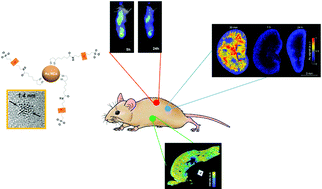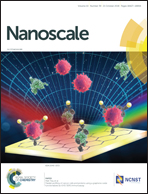Elemental and optical imaging evaluation of zwitterionic gold nanoclusters in glioblastoma mouse models†
Abstract
We report in this study the in vivo biodistribution of ultra-small luminescent gold (Au) particles (∼1.5 nm core size; 17 kDa), so-called nanoclusters (NCs), stabilized by bidentate zwitterionic molecules in subcutaneous (s.c.) and orthotopic glioblastoma mice models. Particular investigations on renal clearance and tumor uptake were performed using highly sensitive advanced imaging techniques such as multi-elemental Laser-Induced Breakdown Spectroscopy (LIBS) imaging and in-line X-ray Synchrotron Phase Contrast Tomography (XSPCT). Results show a blood circulation time of 6.5 ± 1.3 min accompanied by an efficient and fast renal clearance through the cortex of the kidney with a 66% drop between 1 h and 5 h. With a similar size range, these Au NCs are 5 times more fluorescent than the well-described Au25GSH18 NCs in the near-infrared (NIR) region and present significantly stronger tumor uptake and retention illustrated by an in vivo s.c. tumor-to-skin ratio of 1.8 measured by non-invasive optical imaging and an ex vivo tumor-to-muscle of 6.1. This work highlights the pivotal role of surface coating in designing optimum Au NC candidates for cancer treatment.

- This article is part of the themed collection: International Year of the Periodic Table: Precious metals for cancer treatment


 Please wait while we load your content...
Please wait while we load your content...